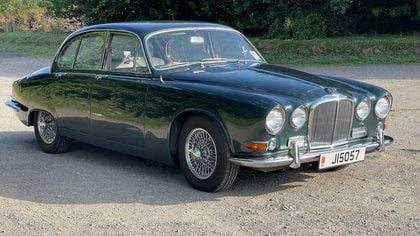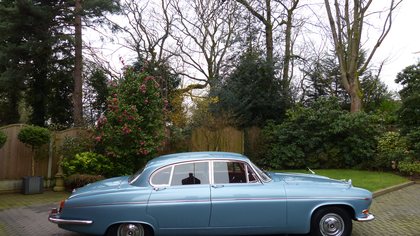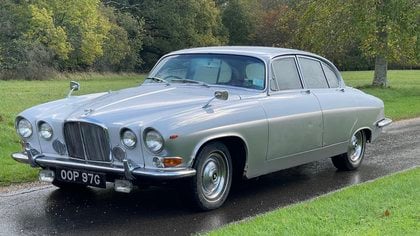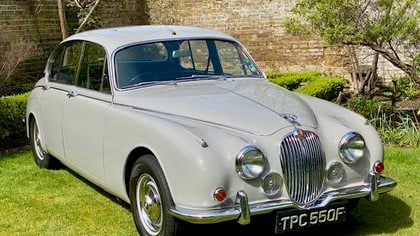Description
1960 Jaguar E2A Le Mans Prototype, ex Gurney, Hansgen, Brabham and McLaren One of the most important Jaguar prototypes, a one-off that bridged the gap between the D and E-Types Cunningham’s 1960 Le Mans entry with Dan Gurney and Walt Hansgen, third fastest overall lap time Period US race history with Sir Jack Brabham and Bruce McLaren Modern Historic competition at Le Mans Classic and Goodwood Conserved in Time-capsule original condition, race preparation by CKL Developments A one-off Jaguar competition prototype, and the Cunningham entry for the 1960 Le Mans 24, E2A is the famous “missing link” between the D-Type and E-Type. Of such historic importance in Jaguar development, E2A remaining in time-capsule original order, raced by some of the era’s greatest drivers, E2A is so special it almost beggars belief she can be acquired as a private possession. The Jaguar works had withdrawn from racing at the end of 1956, choosing to concentrate engineering resources on production cars but supporting privateers like Ecurie Ecosse and Lister. With a rumbling internal debate on a possible return to racing, eventually this one-off competition prototype was constructed from January to February 1960. Perhaps originally intended for test only, agreement was struck to prepare E2A for American racer and constructor Briggs Cunningham to race at that year’s Le Mans. An act of extraordinary trust, this reflected Cunningham’s extensive racing experience, his clout with Lofty England, and likely Jaguar’s appetite for publicity for the forthcoming E-Type. Exquisitely fabricated in riveted alloy, with an aesthetic more aircraft than automobile, E2A featured a monocoque construction evolved from the D-Type, but with the front tubular subframe terminating at the firewall like the E-Type. E2A also featured a revolutionary prototype independent rear suspension by engineer Bob Knight, with the driveshaft used as the upper wishbone – the latter designed after a successful £5 bet with Sir William Lyons it could be done in under a month. An alloy-block 3-litre XK engine with Lucas fuel injection was mated (initially) to a prototype 5-speed Jaguar gearbox with alloy casing. With clamshell bonnet foreshadowing the E-Type, air ducts above the rear wheels directed cooling to inboard rear discs and a diff cooler. E2A travelled to the Le Mans test days in April 1960 still unpainted, and was tested by Norman Dewis and the Cunningham drivers Walt Hansgen and Ed Crawford. Unfortunately aborted after engine failure, Lofty England suspected Crawford missed a gear, and arranged a driver swap to the legendary Dan Gurney for Le Mans. Testing continued back in England, including at the MIRA wind tunnel which consumed so much electricity it was spun up after dark and after an evening in the pub. A tail fin was fitted for directional stability, and E2A was painted in the blue and white Cunningham livery. Anticipation for Jaguar’s return to Le Mans was feverish. Headlines shifted from “Jaguars deny racing comeback” to “Millionaire’s Jaguar is Le Mans Hope” – Jaguar emphasizing the private nature of Cunningham’s entry. Roll oversteer issues at the rear were ironed out, with Gurney becoming unpopular with Dewis in the process. Keen for a fight, newspapers predicted an opening duel between E2A, Ferrari and Maserati, and Cunningham was quoted saying, “Our Jaguar can go the distance and it’s going to keep up the pressure all the way.” Alas, it was not to be. Hansgen took the start, and by the second lap was lying 3rd to Masten Gregory (Maserati) and Olivier Gendebien (works Ferrari). On just the third lap a pitstop with a split injection pipe foretold trouble. As the rain fell, E2A raced into the night working up perhaps as high as sixth – but then a series of pits put her back, finally being withdrawn after seven and a half hours, with a burnt piston and failed head gasket. The 3L engine proved the Achilles heel, ending Cunningham’s seventh attempt on the world’s greatest race. Back at the works, E2A was prepared to spend the remainder of the racing season in the U. S. A. with the Cunningham team in SCCA events. A full 3. 8 litre wide-angle iron block dry- sump engine was fitted, with triple Weber induction rather than the troublesome fuel injection. The taller 3. 8 necessitated fitment of the power bulge to E2A’s bonnet, adopting a famous symbol of the production E-Type and allowing the cam covers adequate clearance beneath. The tall Le Mans regulation windscreen was replaced with a more streamlined fitment at this point. Shipped to America, E2A finished the 1960 season piloted by some of the world’s greatest drivers. On her late-August U. S. debut at Bridgehampton, Hansgen (the 1959 C Modified SCCA champion) cruised to an easy win. Greater challenge followed at the Road America 500 held on September 11th at...


















